8.8 /10 1 Votes8.8
4.9/5 eBay Producer(s) Masayoshi Kikuchi Artist(s) Kazuki Hosokawa Initial release date 26 February 2009 | 8.5/10 IGN 79% Metacritic Director(s) Daisuke Sato Programmer(s) Tetsuya Kaku Writer(s) Masayoshi Yokoyama | |||||||||||||||||||||||||||||||||
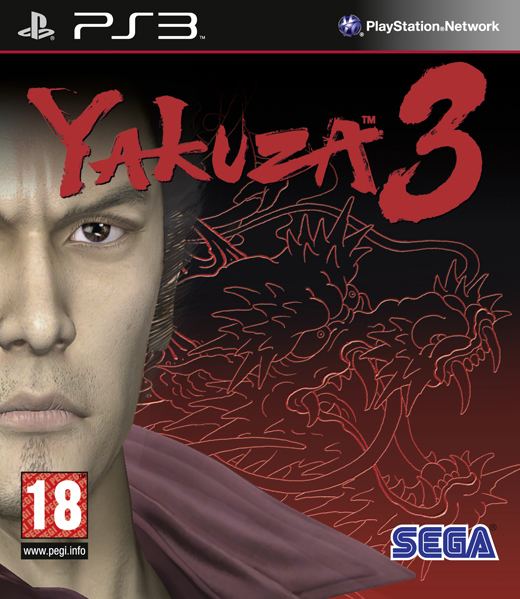 | ||||||||||||||||||||||||||||||||||
Similar | ||||||||||||||||||||||||||||||||||
Yakuza 3 (Japanese: 龍が如く3, Hepburn: Ryū ga Gotoku 3, lit. "Like a Dragon 3") is the third mainline installment in the Yakuza series, released for the PlayStation 3 in 2009. It is developed by Sega's CS1 Team and published by Sega. It was released in Japan and South East Asia on February 26, 2009 and in North America and Europe on March 9, 2010 and March 12, 2010, respectively. The sequel, Yakuza 4, was released on March 18, 2010 in Japan.
Contents
- Yakuza 3 part 1 full story line with all the cutscenes dialogs and english subtitle
- New features
- Event Mode
- Adventure Mode
- Battle Mode
- Completion
- Setting
- Characters
- Story
- Development
- Magical V Engine
- Audio
- Cast
- Soundtrack
- Eastern releases
- Regular DLC
- Extra DLC
- Tie in and product placement
- Western releases
- Licensed movie version
- Release
- Reception
- Sequel
- References
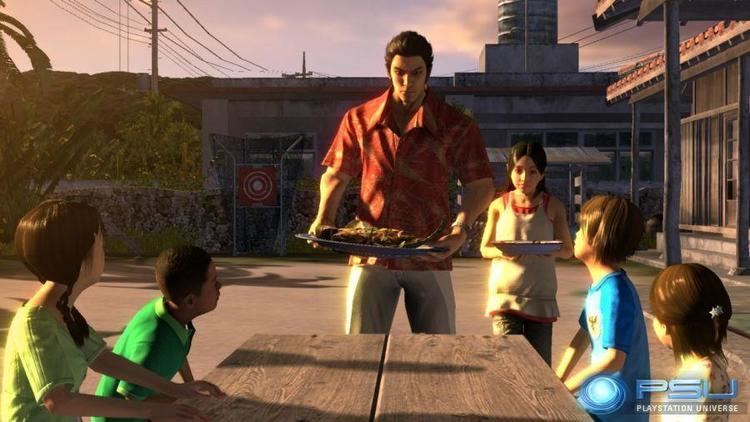
Yakuza 3 part 1 full story line with all the cutscenes dialogs and english subtitle
New features
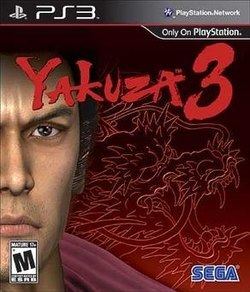
Yakuza 3 introduces PlayStation Network Trophies to the series with 45 trophies (50 in the Eastern releases). It also adds four new gameplay elements as listed below:
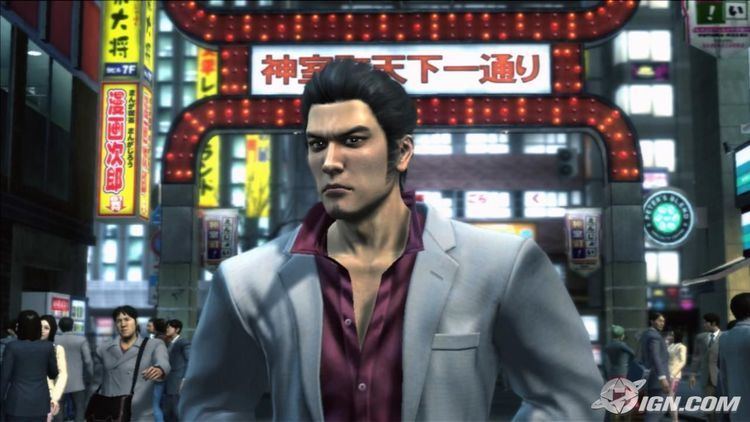
Event Mode
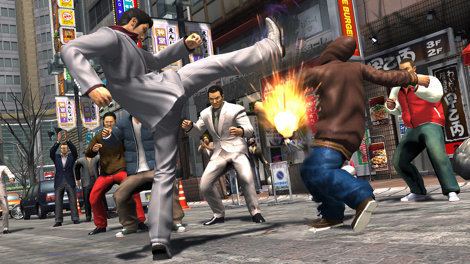
The main story spans over twelve chapters plus a prologue. As with the earlier games, each chapter is preceded by a cinematic, called an "event scene", which later becomes available in the Gallery mode. Skipping these scenes using the Start button can only be done after enabling the scene-skipping option in the menu, which is switched off by default. The western version of Yakuza 3 features 295 minutes of cutscenes according to the BBFC.
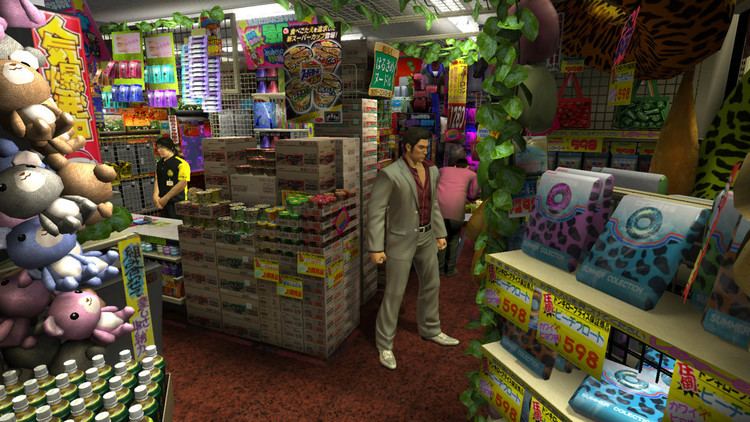
Six sub-scenarios (Date's Pride, Two Fathers, Hometown Girl, The Finishing Touch, Silver Screen Dragon and Murder at Café Alps) are special missions featuring "event scene" cinematics. Holding R1 and pressing the X button will activate an automatic mode that skips the cutscene dialogue.
Adventure Mode
In the eastern releases, the main story is completed with 103 unique side stories called "sub-scenarios" ("substory" in the original version, サブストーリー sabustori). These sub-scenarios are divided into two classes: Mission and Hitman. There are 103 standard missions, some of which are made up of different episodes, and 20 hitman sub-scenarios. Fifteen of these bounty hunter sidestories are located in Kamurocho, the remaining five in Ryukyu.
Twenty minigames are available within Adventure mode. These are aromatherapy massage (eastern releases only), darts, pool, karaoke, bowling, mahjong (eastern releases only), chinchirorin, shogi (eastern releases only), chō-han, koi-koi, oicho-kabu, roulette, poker, blackjack, Answer & Answer (eastern releases only), UFO Catcher, batting cage, golf, surf fishing and Boxcelios. 2-player support for some of these mini games and an expansion for Answer & Answer are added through DLC, as well as main menu direct access in the eastern releases. However, the quiz minigame's expansion was eventually removed from the western release and 2-player support became a time limited DLC exclusive to the North American release's Challenge Pack. Challenges like Mack Shinozuka's training, Inner Fighter 7 and Haruka's Request aren't considered either mini games or side stories.
Beating the game in "Hard" mode unlocks the "Ex-Hard" (extreme hard) extra difficulty level. Completing the game in any difficulty mode will create a "cleared data" save file and unlock "Premium New Game" and "Premium Adventure". The first allows to restart the game with all accumulated money, items, experience levels and fighting techniques. The latter is a free-run mode dedicated to exploration and completion as it doesn't include the main story, with only sub-scenarios remaining (though a small number of missions will only appear at a certain point in story mode, and cannot be triggered in Premium Adventure). Extra game contents are added through DLC.
Battle Mode
As with the previous games, the Underground Coliseum (闘技場, Tōgijō) is available. An illicit mixed martial arts competition sponsored by Majima is held in the area beneath Kamurocho Hills, formerly Purgatory. The arena is inspired by real life Japanese cage fighting competitions such as K-1 World Grand Prix; gameplay is similar to fighting games Toshihiro Nagoshi previously worked on such as Virtua Fighter 5 and SpikeOut. Single Tournament has 50 unique international fighters (a minor character with its own profile) and 11 grand prix tournaments to choose from. These 3-round competitions have various rings, rules and difficulty levels; the different types of tournament are Exhibition Tournament, Street Fight GP, Breakout GP, Heat GP, Bounding GP, Bomber GP, Golden Glove GP, Weapon Master GP, Hyper GP, Magnum Force GP and Maximum GP. Tag Tournament is a two-partner team match including 20 unique teams. Each team is made of paired Single Tournament fighters enhanced with a special duo attack. There are 2 available grand prix named Tag Match GP and Twin Dragon GP. Three Single Tournament fighters and two Encounter Battle characters will join Kazuma Kiryu's "Team Dragon" ("Team The Dragon" in the original release) as tag partners once he finds them in the Adventure Mode; these are boxer Maxim Soldatov (マクシム・ソルダドフ), kenpō Bruce Ebinuma (ブルース海老沼), puroresu Daiji Hiyama (桧山 大治), Keigo Kanno (神野 慶吾) and Masaki Hatae (波多江 真幸). Orders can be given to these partners using the DualShock 3's arrow keys.
Completing the story mode unlocks 35 additional Battle Missions gathered in a bonus mode called Final Competition (究極闘技, Kyōkyoku Tōgi, Ultimate Contest). The first competition has 10 missions and is called "Melee Competition" (乱戦闘技, Ransen Tōgi), the second has 5 missions and is called "Showdown Competition" (対決闘技, Taiketsu Tōgi), the third has 10 missions and is called "Trial Competition" (試練闘技, Shiren Tōgi), and fourth competition has 5 missions and is called "Cooperation Competition". Completing these four competitions unlocks a fifth competition called the Final Competition (究極闘技, Kyōkyoku Tōgi) which has 5 missions. Completing all 35 missions with an "S" rank, the highest rank possible, unlocks a special item delivered by Bob Utsunomiya, which is a talisman called the Fighting God's Talisman ((闘神の護符, Tatagami no Gofū) that, when equipped, permanently maintains the Heat Gage at maximum level.
Once story mode is completed the player can start a Premium Adventure and meet a hidden minor character (a clairvoyant woman) who allows access to four exclusive modes (専用モード, Senyō mōdo) added through DLC, only available in a special edition of the game in Europe, and as a preorder bonus in North America. In Survival Battle Kazuma Kiryu must find and defeat the "Last Boss" (ラスボス, rasu bosu), Yoshitaka Mine; eight bonus bosses are disseminated within Kamurocho. In Survival Onigokko, Kazuma Kiryu is chased by Bob Utsunomiya in Kamurocho, with ten missions to complete in three minutes. All Star Tournament is an extra Arena single tournament that involves all 8 boss characters plus Goh Hamazaki, the latter of which can only be fought in this mode. All Star Tag Tournament is an extra tag tournament that pits Kazuma Kiryu and his fighting partner Goro Majima against 7 teams of bosses and bonus characters such as Kazuki, Yuya, Goh Hamazaki and Komaki.
Completion
The quest for the disseminated 100 coin lockers (half of them are hidden in Kamurocho, the others are in Ryukyu) is rewarded in Yakuza 3 with the "Key Collector" Silver PSN Trophy. The latter was called "Kagi no Hōrōsha" (鍵の放浪者) (lit. "vagrant keys") and was only Bronze level in the Eastern releases. As a mixed game including elements of the sandbox game and RPG genres, Yakuza 3 includes a "Completion" feature that sums up what percentage of the game was actually completed by the player.
Only 100% completion (Completion + Sub-Scenario) will unlock the final mission involving a recurring hidden all-black character named Jo Amon 亞門 丈 (Amon Jo), a.k.a. "Mysterious Hitman", which is returning character from the spinoff and is a secret boss available since the original Yakuza title. In Yakuza 3, Jo Amon's weapon is dual light sabers.
The following extended chart includes the Completion feature and shows the differences between the eastern and western releases. A detailed version of this chart is available in the game's options menu. To learn which contents are specific to each release, see the detailed sections Downloadable content and Versions. Some contents included in the following chart require a completed game save file (such as the Battle Mission), a spinoff game save file (Ukiyo's Bell) or a PlayStation Network redeem code (Battle Pack and Challenge Pack) to be unlocked.
Setting
Unlike Ryū ga Gotoku Kenzan! (often confused with Yakuza 3), which was a Miyamoto Musashi-based spinoff set in Edo period Kyoto, this installment continues the adventures of Kazuma Kiryu from Yakuza and Yakuza 2. The game takes place both in Kamurocho, a fictional version of Tokyo's red-light district Kabukicho, from the first two games and in a brand new location called Ryukyu.
The area of Okinawa where the story takes place is a fictional area, based upon Naha's Makishi. It includes real life landmarks such as the Ichiba Hondori (linked to Mutsumibashi Dori and Heiwa Dori) covered shopping arcade renamed "Karyushi Arcade" (かりゆしアーケード, karyushi ākēdo) in the game as well as the popular Makishi Public Market shortened "Public Market" (公設市場, Kōsetsu Ichiba), the famous entertainment strip Kokusai Street called "Ryukyu Street" (琉球通り, Ryūkyū Doori), the Okinawa Monorail Kencho-mae Station as "Ryukyugai-mae Station" (琉球街前, Ryūkyūgai Mae) or the Mitsukoshi department store (Okinawa Mitsukoshi) which kept its actual name as part of the game's tie-in policy.
Compared with the earlier episodes, the Kamurocho area has some minor changes with additional backstreets and landmarks. Hence South-East Kabukicho's European medieval castle-shaped karaoke box Royal Castle Bldg. (王城ビル) has been modeled and renamed "Kamuro Castle", and north-west Kamurocho love hotel Hotel Aland has been recreated in Kamurocho hotels quarter as the Hotel Tea Clipper.
Characters
Yakuza 3's main characters are Kazuma Kiryu and Haruka Sawamura. Additional castings total three hundred and sixty characters, who appear in the main adventure and sub-scenarios.
Story
Unlike the previous episodes the story is not written by Hase Seishu but by Masayoshi Yokoyama. Yakuza 3 takes a departure from the first two games with its choice of setting: instead of focusing on the gritty cityscape of Tokyo and Osaka, it switches gears and sends Kazuma Kiryu to the Ryukyu Islands, Okinawa, where he runs the Sunshine Orphanage (Morning Glory (アサガオ, Asagao) in Japanese) with his adoptive daughter Haruka Sawamura (she calls him "Uncle Kaz") who accompanied him in the previous episodes and the Movie Version.
Sunshine Orphanage is on a land that is owned by Shigeru Nakahara, the boss of a local yakuza clan or bōryokudan, known as the Ryudo Family 琉道一家 (Ryūdō Ikka). Nakahara is under pressure from the country's government to sell the land, which is planned to become a seaside resort. When his friend Daigo Dojima, Chairman of the Tojo Clan, is shot, Kiryu must deal with the three gang bosses who arranged the attempted murder.
The game ends with Kiryu succeeding in his mission, and he and Haruka meet to explore the town. Kazuma is confronted by a mysterious man, who is revealed to be Goh Hamazaki, having survived the offscreen attempt on his life. In anger, Hamazaki stabs Kiryu in the stomach, and is subdued afterwards, leaving a critically wounded Kazuma to give dying words to his adopted daughter.
In an after credits scene, the orphanage's children gather to play. As Haruka stands near a man, who, as the camera turns, is revealed to be a bandaged Kiryu, having survived the stabbing, and he goes to continue running Sunshine Orphanage with Haruka helping him.
Development
The game's default video output is 720p HD graphics rendering at a resolution of 1024x768 without anti-aliasing but it supports 1080p mode upscale.
Daisuke Tomoda, CS1 Team (Sega CS R&D) visual artist and character design team leader of the Yakuza series since the original episode, partially unveiled Yakuza 3`s development at the 2009 Game Tools & Middleware Forum seminar held in Tokyo on June 15. Yakuza 3 character designing began shortly after the completion of Ryū ga Gotoku Kenzan! in 2008 with a three-week project phase followed by an eight months production. In the end 110 high polygon characters, for they appear in Event Scene cinematics, plus 250 minor characters were created by 60 teams producing a dozen characters each. Thus 360 characters were produced following a "one person one body" philosophy and a three-day-per-body target schedule. As a comparison, the production of Yakuza on PlayStation 2 took 10 months and had no more volume. The series' production pace is one game per year since the original Yakuza in 2005. CS1 used a slogan to describe the game's graphics: "Not Reality but Real (リアリティではなくリアル, Riariti de wa naku riaru).
Magical V-Engine
As with the previous PlayStation 3 Ryū ga Gotoku game, main characters have their face scanned through Cyberware's head & face color 3D scanner (model PS). As detailed at the GTMF 2009, Event Scene cinematics are real-time and render highly detailed XSI 6.5 2.5MB data size characters using 18,000~20,000 polygons each; 3D model bones are made of 107 meshes with 64 used for the body and the remaining 43 used for the face. In addition, the PlayStation 3 employs advanced graphics technologies without LOD, texture size 512×512 front buffer with 512×512 back buffer, diffuse map and normal map, multi map (ambient occlusion, specular mask, 8-bit specular power RGB) within cutscene. These Event Scene cinematics fully exploit Sega's in-house facial expressions engine called Magical V-Engine. This engine is based on a unique "wrinkle shader" technology 皺シェーダー (Shiwa shēdā) that allows for advanced facial animation from voice recordings alone. By animating based upon not only the phonetic lip syncing but tone, the software can emulate the basic human emotions in full facial expression. The same technology was used in Ninja Gaiden Sigma 2.
Audio
Yakuza 3 outputs uncompressed or compressed audio, respectively Linear PCM 2ch/5.1ch (stereo or surround) and Dolby Digital 5.1 surround.
Cast
The game's main characters have their face modeled in 3D after their voice actors, who are Japanese celebrities. Softimage XSI 3D data is obtained by scanning a human head with Cyberware Inc.'s latest scanner. These include returning voice actors Takaya Kuroda (as Kazuma Kiryu), Rie Kugimiya (as Haruka Sawamura), Hidenari Ugaki as Goro Majima, and TV actor Satoshi Tokushige (as Daigo Dojima).
New faces are film actors Tatsuya Fujiwara (as Rikiya Shimabukuro) known overseas for his Shuya Nanahara role in Kinji Fukasaku's Battle Royale and Battle Royale II: Requiem, Nakamura Shidō II (as Yoshitaka Mine) who featured in Ronny Yu's Jet Li is Fearless and Clint Eastwood's Letters from Iwo Jima, actor Tetsuya Watari (as Joji Fua) famous for his yakuza roles in Seijun Suzuki's Tokyo Drifter, Kinji Fukasaku's Graveyard of Honor and Takeshi Kitano's Brother, singers and tarento Shigeru Izumiya (as Shigeru Nakahara) and George Takahashi (as Goh Hamazaki), voice actor Akio Ōtsuka (as Ryuzo Tamiya), tarento Daisuke Miyakawa (as Mikio Aragaki) and Hiroyuki Miyasako (as Tsuyoshi Kanda).
Soundtrack
The Ryū ga Gotoku 3 Original Soundtrack (HCV-452) was published by Wave Master in Japan on February 26, 2009. It was bundled as a bonus enhanced CD in the Yakuza 3 PAL version's standard deluxe edition called the Battle Pack. The music was composed by Hidenori Shoji, Kentaro Koyama, Takahiro Kai, Hiroyoshi Kato, Yoshio Tsuru and Hideki Sakamoto, and includes a track by Love Sound System (DJ Giuliano, Ayako, Yoshiji Kobayashi). Performers are Minako Obata (a.k.a. Mooki), Chihiro Aoki (chorus) and Mitsuharu Fukuyama (trumpet). Two Karaoke minigame songs are also included, performed by voice actors Takaya Kuroda (Kazuma Kiryu) and Rie Kugimiya (Haruka Sawamura). The track list for Yakuza 3 has 31 titles (details are available below).
Additional soundtrack includes three songs by Japanese rock music artist Eikichi Yazawa.
Eastern releases
Eight DLCs were delivered through a weekly game update campaign starting on March 5, 2009, with one DLC per week. These downloadable contents consist of:
Four Premium Adventure exclusive modes are also added through DLC, these are:
Regular DLC
Four lots of DLC were delivered on release day with the PAL version's Battle Pack (a.k.a. Premium Pack). These free downloadable contents are:
All this DLC is also in the Japanese version. Regarding the western release of the DLC, a Sega America spokesperson officially stated on February 24, 2010: "[T]he western versions of the game will come pre-packaged with codes for the DLC, already localized and ready to be enjoyed".
Extra DLC
Two exclusive extra DLC codes were sent only to North American customers who pre-ordered Yakuza 3 in their local GameStop stores. These additional downloadable contents were:
This pre-order only extra DLC are also available for the Japanese version, for which they were delivered for free through an eight-week downloadable content campaign. This DLC can now be downloaded on the PlayStation Network for $4.99. This was also released with pre ordered in U.K.
Tie-in and product placement
Producer Toshihiro Nagoshi made twenty-seven tie-in with local companies to produce 3D model reproductions of existing shop, restaurant or hostess bar buildings. Such replicas include real exterior, interior, products, menus and sometimes jingles.
Kabukicho's tie-in are Club Sega game centers, Don Quijote discount stores, Matsuya restaurants, Pronto cafés (a Suntory joint venture) and Karaoke Kan. Collaboration with Sole tanning studio, Promise, Aeon and Geos is limited to visible ads within Kamurocho.
Okinawa's tie-ins are Blue Seal ice cream parlor, Quickly bubble tea stand, Sam's Maui steak house, Stone Market accessory shop, Okinawaya (おきなわ屋), Okinawarigura (泡盛蔵) liquor store and Velotaxi Japan. Limited collaborations include the exterior design of Naha's Apa Hotel, Okinawa's Mitsukoshi and OPA department stores (which cannot be entered). Orion draft beer, Tantakatan (鍛高譚) shōchū, Higashuzou (比嘉酒造) awamori and Skymark Airlines have ads visible within the Downtown Ryukyu area.
Sega extended its product placement policy which was introduced in the original episode. Now real products can be bought within discount and convenience stores including Axe fragrance, various Ace Cook instant noodles, several Suntory beers or soft drinks (such as Boss Coffee and C.C. Lemon), Pepsi soda (a Suntory licensee), Kodansha magazines (including Young Magazine, Weekly Morning and Vivi). This also applies to bars and pubs, since the Suntory group produces alcohol and owns many licenses for foreign alcoholic beverages like Early Times whiskey, Beefeater Gin, Courvoisier cognac and Carlsberg Beer. Suntory vending machines are still disseminated within Kamurocho as in the previous games.
Some sub-scenarios even resolve around product placement with minor characters specially created to advertise products, for example the sidestory involving Ace Cook noodles and the fictitious ramen shop Kyushu No. 1 Star (九州一番星, Kyūshū Ichibanboshi) or Young Magazine and the generic convenience store Poppo. Some items on the food and drink menu, required for 100% completion, cannot be purchased without first being in possession of a copy of Tokyo Isshukan.
Eastern releases
Kamutai Magazine bundle
As part of the pre-ordering campaign, the Japanese and Asian first prints were bundled with a limited item, a monography called Kamutai Magazine (February 2009 issue).
Rising Dragon Pack
Sony celebrated the Japanese release of the game with a 10,000 console limited edition of the Ceramic White 80GB model PlayStation 3 called the "Ryū ga Gotoku 3 Rising Dragon Pack" (龍が如く3昇り龍パック, Ryū ga Gotoku 3 Nobori Ryū Pakku).
Ukiyo's Bell
The eastern versions include an exclusive extra Adventure Mode item. If the game detects an existing save file of Ryū ga Gotoku Kenzan! stored on the PlayStation 3 hard disk drive, a reward item will be unlocked in Ryū ga Gotoku 3 upon beginning a new game. This is a red copper bell called "Ukiyo's Bell" (浮世の鈴, Ukiyo no Suzu) used by Miyamoto Musashi (a.k.a. Kazumanosuke Kiryu) in the spin-off, which grants 3 points in the defense, edge and firearm stats when equipped. The bell was carried on to Yakuza 4, and retains its appearance, but is renamed Gion's Bell, and instead of protecting the wearer, it rewards money for every step taken.
Western releases
Localization
The PAL version features the Japanese voice cast (with localized subtitles) and includes a previously unreleased 18-minute video interview of Tamiya according to the BBFC.
Other bonus contents include a free compact disc with the game's original soundtrack and an animated character guide. Western packages also come with PlayStation Network redeem codes to unlock DLC; these western bundles are called Challenge Pack (time limited) and Battle Pack (regular).
Although the game was not censored for the western release, much extra content was removed due to time constraints. According to a Sega representative:
"The content between Yakuza 3 US/UK and Yakuza JP is a little different in that we took out certain bits in order to bring the game to the west in the time alloted [sic] for us to do so. The parts we ended up taking out were parts that we felt wouldn't make sense (like a Japanese history quiz game) or wouldn't resonate as much (such as the concept of a hostess club). We didn't replace the parts we took out, but we made absolutely sure that the story continuity stayed intact so that the story experience was the same as the Japanese version and that it didn't take away the human drama so inherent to the Yakuza series."
The western localization of Yakuza 3 was officially unveiled by Sony and Sega in late December 2009. The same month, Sega Australia managing director Darren Macbeth declared in an interview with GameSpot:
"The publisher needs to be comfortable enough that there is a strong market in the West before giving the go-ahead to local Japanese releases like the Yakuza series. In a lot of cases we have a very strong vocal group of fans, who demand the opportunity to play these games in their local markets, and are very outspoken in their support. However, when the time comes, they are reluctant to stay committed and actually make the purchase."
Removed content
On February 24, 2010, a Sega America Blog community manager officially declared:
"We wanted to confirm that there is some content in the Japanese version of Yakuza 3 that didn’t make it over to upcoming Western version, mostly involving the Hostess Clubs and the Japanese History trivia sections. [...] The choice that had to be made was either no Yakuza 3 in the west, or a version of the game that was almost exactly the same, but with a little less trivia."
This statement was an answer to IGN journalist Greg Miller's unofficial insight report of February 23 claiming:
"Even though the hostess clubs are out, you can still go on dates with the girls.[...] The strip clubs are still in Yakuza 3."
The referred strip clubs are "Show Pub Asia: Kamurocho Asia Beauty Show Dance and Pole" and Ryukyu's "Canal Grande: Cabaret Club", both are linked to main and side stories in the original Japanese release and therefore were not removed as confirmed by a new game trailer. A video showing the game's locations and was officially released by Sega on February 25. A Sega PR further commented to Kotaku blog on February 24, 2010:
"We had a tight schedule to abide by for localizing and releasing Yakuza 3 in the west. Due to the limited time we were given we had to leave certain bits of the game out and we chose portions we felt didn't resonate with western culture i.e. a Japanese history quiz show and the concept of hostess clubs. [...] Given the options of releasing the next chapter of a beloved game so that our fans can experience the story of Yakuza vs. not releasing it at all, we felt it was worth it to release it with 99% of the content intact. We made sure that the story in no way, shape or form changed from the lack of the quiz show or hostess clubs. You can still go into Cabarets and on dates with the ladies in the game."
Sega gave no further details about what was cut, but comparing the eastern and western releases PSN Trophy lists revealed that five trophies (out of 50) had been removed, two sub-scenario missions (out of 103) were cut as well half-aspect of romancing the club hostesses (out of 10 completion challenges) and four minigames (out of 20). The remaining 45 trophies are the same as in the original Japanese 2009 release, except two Bronze trophies, named "Legendary Champion" and "Key Collector", were upranked as Silver trophies. Removal of a first trophy called "Good Coordination" (グッドコーディネート, Guddo Kōdinēto) hinted that the sidestory called Creating a No.1 Hostess! (No.1キャバ嬢をつくろう!, No.1 Kyabajō) was cut. This mission consists of scouting a young female NPC in the Downtown Ryukyu (Shoko, Hiromi, Shō and Kirie) or Kamurocho (Ritsuko) areas, and to make her the top hostess at cabaret club South Island, by customizing her physical aspects (with variable parameters such as make-up, haircut, outfit and à la mode accessories). A similar club management mission was introduced in Yakuza 2, in which the club, rather than the girls, is customized. Club or "cabaret" hostesses are a common phenomenon in Japan and have dedicated fashion magazines; such as Koakuma Ageha which is a tie-in with the game. This mission reappeared in Ryū ga Gotoku 4.
Removal of a second trophy, "Futoppara" (太っ腹, "Generous"), hinted that the ten-episode hostess clubs completion challenge キャバクラ (Kyabakura, "cabaret club") had been partially cut, since the trophy is unlocked by spending a large amount of money in Club Ageha, Club Koakuma and Flawless. In this multipart completion, which is a romancing challenge, Kazuma Kiryu orders food and drink while conversing with the ten hostesses. All characters are modeled after a real Japanese hostesses cast and this gameplay element was introduced in the original Yakuza episode. The possibility of romancing club hostess characters outside clubs in the western releases of Yakuza 3, as officially announced by the Sega representatives, was eventually confirmed by the presence of Mika Tsuchiya of Flawless playing the pool minigame on the game's back cover. This possibility is inherited from the Japanese version since the romancing completion challenge actually includes both hostess club dialogues (ordering meals and offering presents) and dating activities such as dual sessions of pool, darts, bowling and karaoke. If the former text part was cut, the latter dating part, which requires a minor translation work, definitely remain in the western releases. While the hostesses remained, the trophy was still removed since it was impossible to spend money on them within the club setting.
The third trophy to be removed was "Esthe mania" (エステ・マニア, Esute Mania) which requires the player to take the Love In Heart massage parlor's two courses. This erotic minigame was cut along with its connected sidestory, "...About Me?" ((俺のこと?, Ore no Koto?) where the masseuse, Ayaka Tsubaki, reveals to Kiryu that she is actually a transsexual. This minor character is modeled after her voice actor, Ayana Tsubaki, who is a Japanese TV personality and a transsexual herself.
The fourth and fifth cut trophies, "Fudō no Kishi" (不動の棋士, "Immovable Shogi Player") and "Sarashi no Ryū" (晒しの龍, "Bleaching Dragon") respectively were the first sign that both shogi and mahjong minigames had been removed from the western releases. These are based on traditional board games that are fairly popular in Japan, yet uncommon overseas.
Another confirmed cut was Kamurocho Club Sega's Answer & Answer, a Japanese history quiz minigame based on the real Sega arcade game, which is only available in Japanese game centers. The last cut was an Adventure Mode unlockable bonus item, Ukiyo's Bell, which is awarded to players of the eastern-only PlayStation 3 spinoff Ryū ga Gotoku Kenzan! and, as such, would be both impractical and impossible for the majority of players.
Challenge Pack
According to a community manager's official announcement on the Sega America blog:
"Yakuza fans who pre-order the game at their local GameStop will receive additional content via the Challenge Pack. This will allow them to enjoy 2 player mini games, competing against their friends at Pool, Bowling, Darts and Golf. They will also be able to customize their principal characters with four alternative costumes for Kazuma, Haruka and Rikiya."
Battle Pack
The PAL version was released as a standard deluxe edition called Battle Pack (or Premium Pack). The package's sticker lists the following free contents:
"Bonus enhanced CD soundtrack with a guide to Who's Who in the world of Yakuza + 4 pieces of unlockable content."
As an ECD, this CD contains both audio and interactive features. The audio part is the full OST featuring the 31 tracks licensed by JASRAC; it was previously sold by Sega's audio branch in the Japanese market and is now offered to western customers. The data part cointains a fully animated characters guide called Yakuza Who's Who; like the OST these profiles are exclusive to the western releases.
Licensed movie version
North American video distributor Tokyo Shock (Media Blasters) set the release date and cover art of its licensed DVD version for Yakuza: Like A Dragon in order to match the local marketing for Yakuza 3. The English subtitled version for Takashi Miike's 2007 live-action film adaptation of the first Yakuza game was originally planned for a March 2010 release date; the release schedule was eventually changed to February 23, 2010.
Release
A free demo version was released on the Japanese PlayStation Store on February 19, 2009. The same demo was released on the European PlayStation Store on February 18, 2010.
Due to their commercial success all Asian versions had bargain re-releases, a PlayStation 3 the Best edition in Asia on November 30, 2009, then in Japan on December 3, 2009 and a PlayStation 3 BigHit Series edition on December 11, 2009 in Korea.
Reception
The Japanese industry gave it the "Award for excellence" in the Japan Game Awards 2009's "Games of the Year Division" for its "Dramatic story development, freedom of the story and the graphics elaborated up to the details of the work. In addition, amusement found in every portion of the game including the vast number of sub-stories and mini games. This work was awarded the prize for the high quality of entertainment." Yakuza 3 also earned SCEJ's PlayStation Award 2009 Gold prize for achieving more than 500,000 sales in the Japanese market. Other Gold Prizes were Resident Evil 5 (PS3) and Dissidia Final Fantasy (PSP). It was also well received in the west, with the UK's Official PlayStation Magazine awarding it 9/10; however, it was criticised for the removal of content during localization.
Yakuza 3 is the second best selling 2009 PlayStation 3 game in Japan, following Square-Enix's million-selling Final Fantasy XIII but outselling Capcom's Resident Evil 5 blockbuster, and is part of 2009's best-selling titles in this market with 499,436 copies sold as of December 7, 2009 according to Weekly Famitsu. By March 27, 2010 Yakuza 3 had sold more than 683,905 copies.
Sequel
Yakuza 4 was released in Japan in March 2010, and was released in North America and Europe at the first quarter of 2011. A spin-off game, Ryū ga Gotoku Of the End, was originally scheduled for release in Japan in March 2011, however due to the earthquake the game was delayed until June 2011.
